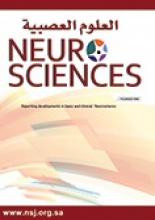Abstract
Seizure disorders are very common and represent the most common cause of referrals to pediatric neurology. Epilepsy, defined as recurrent unprovoked seizures, is also common with a frequency of 4-8 cases per 1000 children. In Saudi Arabia, inherited neurological disorders, including epilepsy and genetic epilepsy syndromes, are more common because of the high rate of consanguinity. This article attempts to provide an updated overview of pediatric epilepsy and review the most recent diagnostic and therapeutic guidelines. Seizures in children have wide variations in clinical expression with age specific presentation. Although epilepsy is a clinical diagnosis, EEG often provides supportive evidence and helps in seizure classification. Epilepsy syndromes are more common in younger children, and their proper diagnosis provides valuable genetic, therapeutic, and prognostic information. Magnetic resonance imaging is superior in identifying congenital or developmental abnormalities and should be performed in preference to CT. Monotherapy is the best management approach for better compliance and to prevent interactions or side effects. To conclude, epilepsy remains a clinical diagnosis and therefore, careful and detailed history remains the cornerstone of an accurate clinical diagnosis.
- Copyright: © Neurosciences
Neurosciences is an Open Access journal and articles published are distributed under the terms of the Creative Commons Attribution-NonCommercial License (CC BY-NC). Readers may copy, distribute, and display the work for non-commercial purposes with the proper citation of the original work.






